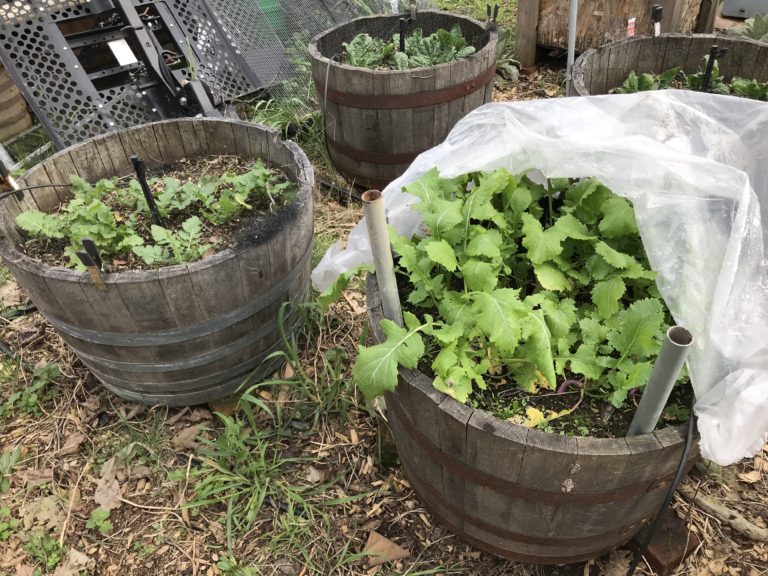The ongoing potato box experiment has moved into a new winter test phase. My first year using them was 2021. Built on a pallet base, they measure 24” x 24” square and 20” tall, with the OSB sides unattached so they can be slid up to at harvest time which is convenient and ensures you find every spud. Because, man! – stray potato tubers can be wily. 5+ years after first growing them in the ground I still occasionally find a potato vine coming up like a weed.
Last year, in the initial launch, I used two of the six boxes to test the internet hack of growing potatoes only in straw – “potato tower” style, which is basically the idea of the Ruth Stout method in a container. The deconstructed and purely theoretical idea of potato tower, I should say, because the Ruth Stout method relies on the seed potatoes rooting into the soil and drawing nutrients from there (hugely enriched from her years of in situ composting). But sitting in straw alone, without the rich moisture-holding soil, in a box getting beaten by the summer sun – the straw dries out quickly and growth is stunted. The whole idea of growing potatoes in nothing but straw like this pic is a flat-out lie.
In doing some of my usual neurotic and excessive rabbit hole research for this post, I came across this fantastic analysis of the entire phenomenon of potato towers, from biological to societal, complete with google trends graphs tracking how they myth spread through the internet. Check out Cultivariable, it’s great. I have nothing more to add on the subject, and considering how thorough that piece is, neither does anyone else ever again.
Okay, enough digression – what is Potato Box Phase II? Supplemental lighting!
Last year in the greenhouse I tried supplemental lights for the first time to add in some UV rays missing from the wintertime sun. It worked adequately enough that I saw the potential, and I’ve boosted the attempt this year. I’m all about systems, and at the moment, it seems the best system for the potato boxes is: potatoes in the summer, spinach in the winter, with garlic surrounding the edges.
It’s really a great time to be growing with lights – what I mean by that is the best time in history. Instead of the hugely expensive and energy intensive grow lights of the past, today you can get low voltage daylight spectrum LED bulbs for less than four bucks each on Amazon. These 6000K bulbs run on AC or DC, 10-30v – so simple and versatile. Using low voltage DC power is totally safe and efficient – mere pennies a day, as the phrase goes. I found a bathroom light bar free on Craigslist and pulled the sockets from that. Mounted them on some 1/2″ PVC pipe with some pie tin reflectors. Basically each box light cost about $4.50.

I also like how the PVC will provide support for clear plastic sheeting to easily make a mini hoop-house. And for now, it supports the bird netting keeping the squirrels out. I’m a fan of using PVC to create arcs and overall PVC tinker toy construction. PVC is so fun.
I do know from last year’s winter experiments that adding some plastic sheeting really boosts growth, even with classically cold weather plants. Here’s the result of turnips, pic taken on March 27, 2022. The seedlings were started indoors on Jan 10 and transplanted Feb 10, and the difference is obvious.

And super thrifty tip? For all your clear plastic sheet needs, for God’s sake, don’t go to Home Depot and pay ridiculous money. Go to the dumpster behind a mattress store. Mattresses come wrapped in super thick protective plastic – like 10+ mil plastic. I’ve done that for years now, and even though I doubt it’s UV protected, they still seem to last a long time. I’ve reused a number of hoop house sheets over and over each year until they break down.
A few years ago, largely because of the huge expense of extending AC current through the yard – both the cost of the materials but especially all the permits and because I’d definitely need to hire an electrician to add a circuit to my overtaxed breaker box – I started gradually with 12v DC around the yard, powered by some cheap 10-amp DC transformers. After about 5 years of that organic growth, I now have a whole network of safe, cheap, legal 12v power sprawling all over the yard. There’s lighting in the sheds and greenhouse, lights and valves and pumps and quackaponic grow lights for the duck compound, general borders and accents, and of course, aesthetic fun lights such as the “whole lotta gin”…

I think having the system built around 12v should be nice and simple whenever I finally add in the solar panel I keep planning – no inverter needed or other load issues.
But the question that matters – will the lights work and keep my spinach growing even in the darkness of winter? Signs point to an observable advantage so far. After only a week with the light, here’s a comparison. (I ran out of bulbs, so even though there’s the light mount, there wasn’t any bulb in there for awhile).

Of course, the Rabbit Hole of Research swallowed me up on the topic of grow lights. Indoors, I do have a couple typical Blue-Red (“blurple” as they say) LED growlights that I bought years ago on Amazon, relatively cheap, for plant starts. I spent stupid many hours trying to figure out wavelengths and plant needs and color temps and photosynthesis, etc.

Bottom line – saying “plants only use red and blue light for photosynthesis” is untrue. Obviously, they use the full spectrum. In fact – you can grow plants with only green light, which is often used in commercial greenhouses because its considered the “weakest” with the intention that people can see but the plants think it’s their dark cycle. This great YouTube vid demonstrates it very well. One thing not mentioned, which I picked up somewhere is thinking of the blue and red lights as seasons – Spring and Summer. Spring is blue, when the light is bluer, and promotes more green growth. Summer is redder light, to promote flowering.
# # #
